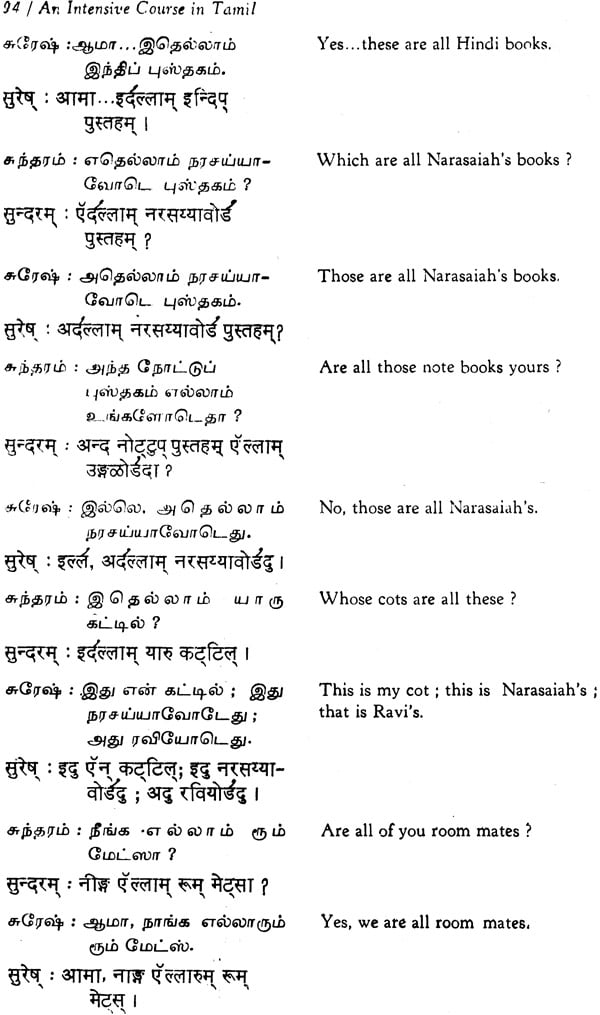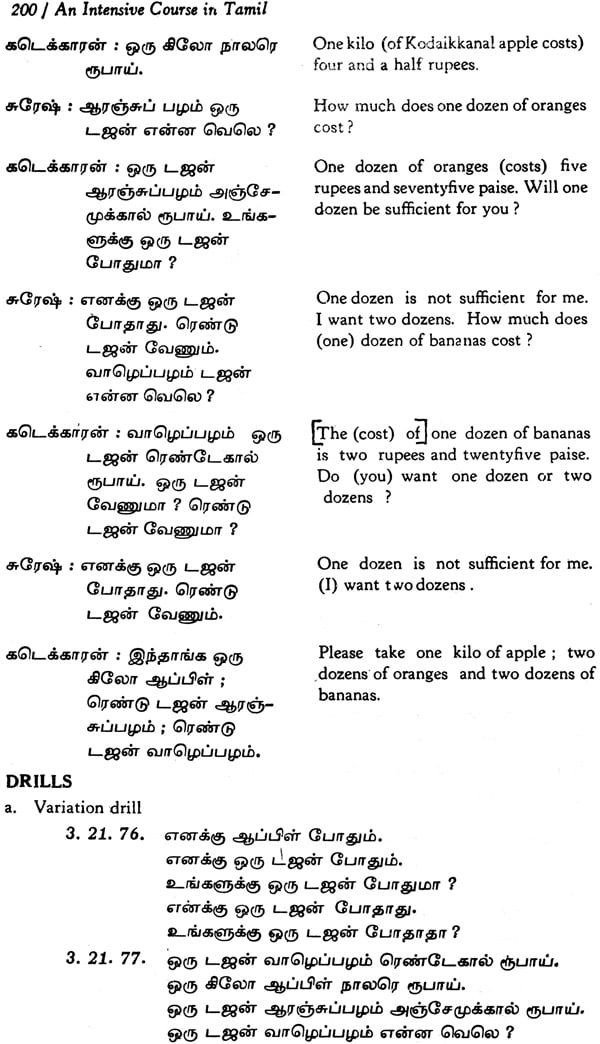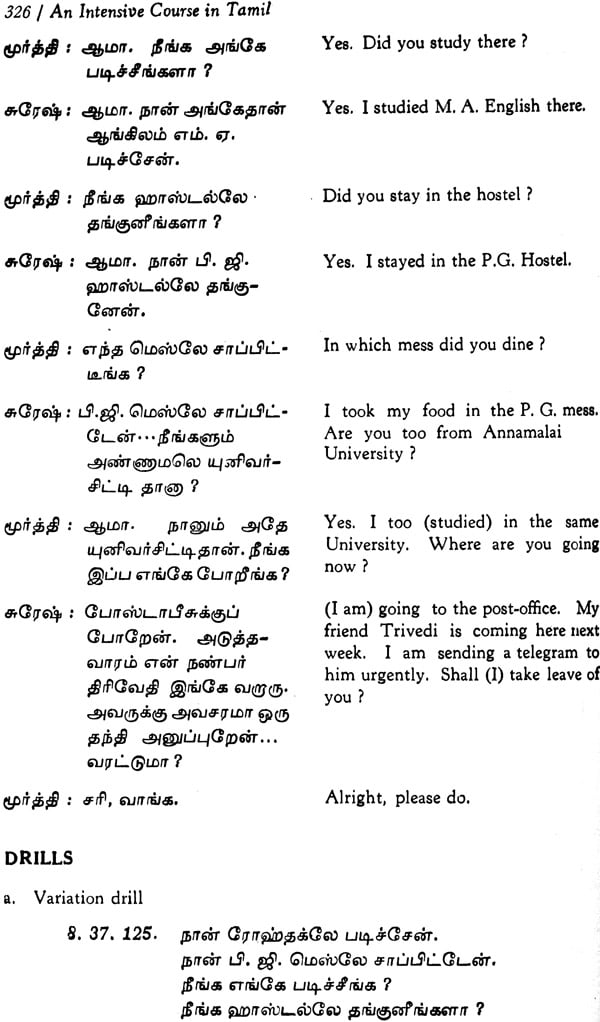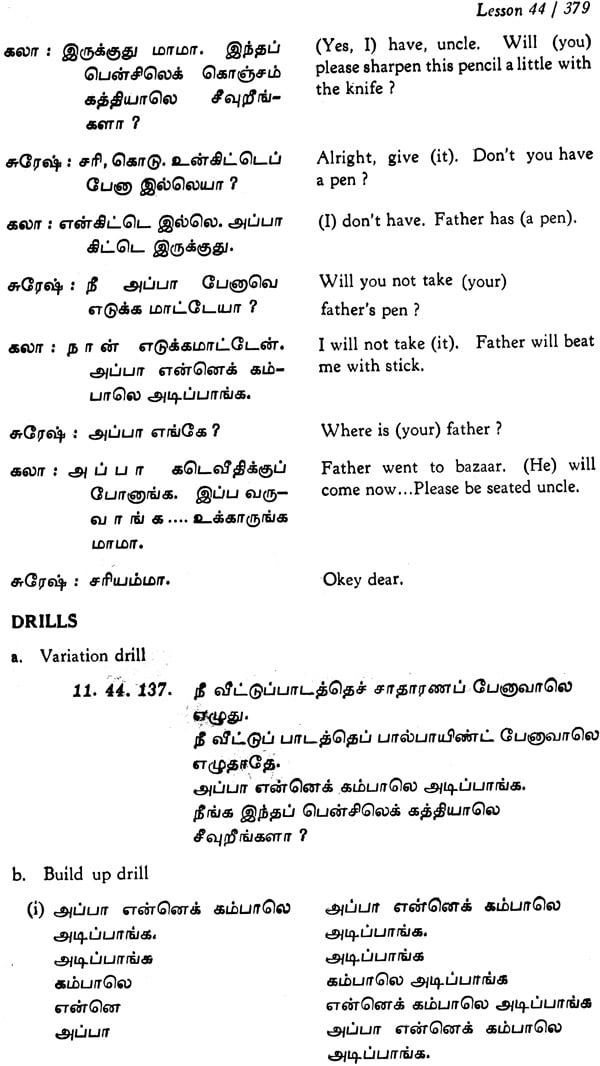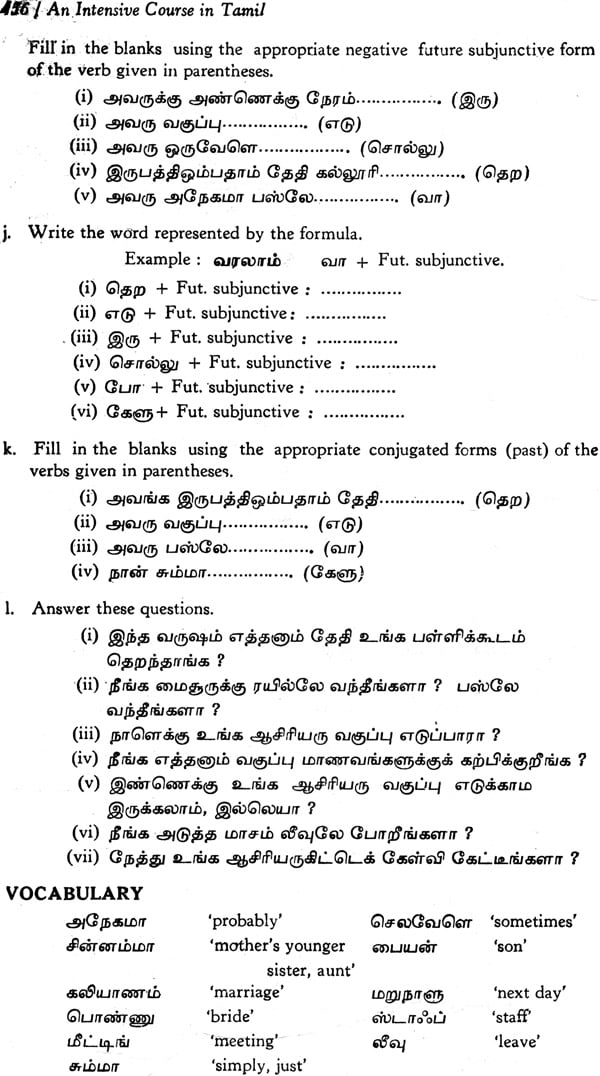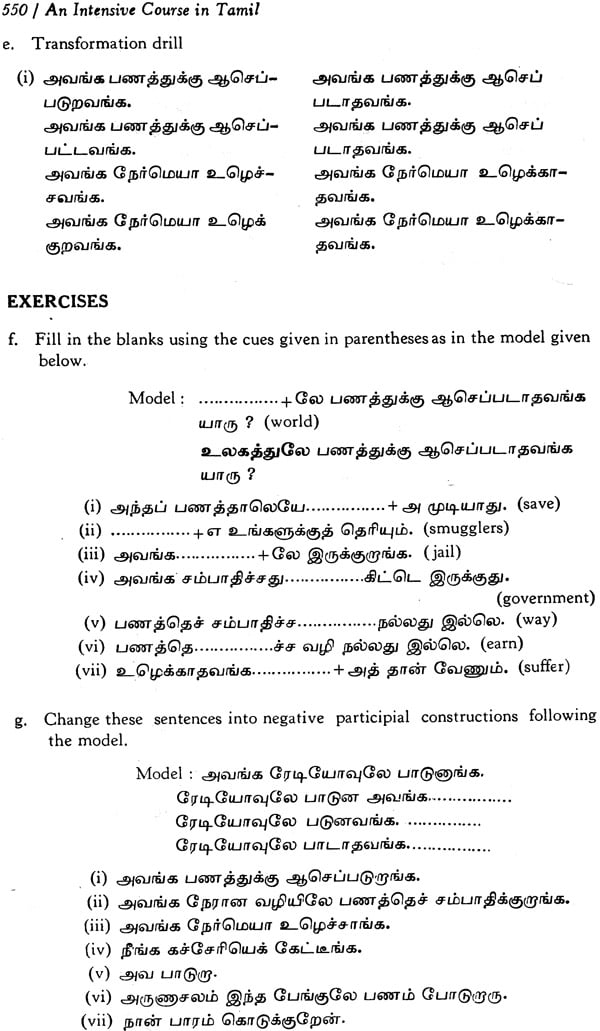
An Intensive Course in Tamil (An old and Rare Book)
Book Specification
| Item Code: | NAK536 |
| Author: | S. Rajaram |
| Publisher: | Central Institute of Indian Languages, Mysore |
| Language: | Tamil Text with English Translation |
| Edition: | 2000 |
| ISBN: | 8173420238 |
| Pages: | 868 |
| Cover: | Hardcover |
| Other Details | 9.5 inch x 6.5 inch |
| Weight | 1.30 kg |
Book Description
Foreword
The Central Institute of Indian Languages was set up on the 17th July, 1969 with a view to assisting and co-ordinating the development of Indian languages. The Institute was charged with the responsibility of serving as a nucleus to bring together all the research and literary out-put from the various linguistic streams to a common head and narrowing the gap between basic research and developmental research in the fields of languages and linguistics in India.
The Institute and its five Regional Language Centres are thus engaged in research and teaching, which lead to the publication of a wide-ranging variety of materials. Preparation of materials designed for teaching/learning at different levels and suited to specific needs is one of the major areas of interest of the Institute. Basic research relating to the acquisition of language and study of language in its manifold psycho-social relations constitute another broad range of its interest. The publications will include materials produced by the members of the staff of the Central Institute of Indian Languages and its Regional Language Centres and associated scholars from Universities and Institutions, both Indian and foreign.
The Central Institute of Indian languages has initiated a Basic Course Series in major Indian languages to provide suitable and 'comprehensive material for learning' and teaching the language concerned for Indians. In a language teaching situation, the teacher is expected to combine the roles of a psycho-linguist, socio-linguist, linguist, language pedagogue, a creator of materials, a literary critic and a testing and evaluation expert. Most of his competences are naturally reflected in the materials, which simultaneously are graded from simple to complex, known to the unknown and contrived to the natural. This is a very difficult task. After research and experimentation we have come out with more questions than answers at each stage of the material. For example, how basic is basic? What is grading? In what way can linguistic and cultural matter be graded? Is question, with which most learning, begins, simpler than statement? How does one move from a purely language based competence to creating literary sensibilities? How does one build into the material conceptual prose? How are lessons to be presented? Should the translated discourse structure be made to look similar to the original discourse structure? Questions such as these have been answered differently by different teachers and researchers.
This search is a continuing phenomenon. Therefore, these materials represent our unfinished education in this area.
The format for the basic course is the result of a consensus arrived at by the lecturers and Principals of the five Regional Centres of the Institute engaged in the teaching of major Indian languages. This is the product of almost eight years of teaching and research. This format is flexible and has left much scope for individual authors to innovate. If these courses help the desirous to learn and stimulate those interested in applied linguistics, with special reference to the teaching of Indian languages as second/ foreign languages, then the Institute would feel rewarded.
I congratulate the teachers, the trainees, the supervisors and the press and publication people who have brought out the publication in a creditable manner.
Introduction
Language learning is a complex activity. Its success is largely determined by the method, medium, material and the motivation of the learner. The highly organised curriculum and planning show the way to achieve the educational goal with ease and rapidity.
The present Intensive Course emphasizes listening and speaking skills. The Phonetic Reader, the Script Book, the Recall Vocabulary (semantically classified), the Hindi-Tamil Common Vocabulary and several other reading and writing materials envisaged by the Central Institute of Indian Languages for use in the basic course stage of its Regional Languages Training Programme, may be used with profit along with this book.
The present book is intended mainly to be used in the basic course stage of the Tamil language training programme 'of the Central Institute of Indian Languages. The entire training programme has the duration of 10 months, i.e. about 1100 clock hours. This period is divided into three stages, namely, basic course, intermediate course and advanced course. The basic course has about 450 clock hours of instruction with primary emphasis on the spoken language. The present Intensive Course is the prescribed instructional material for the above mentioned course aiming at listening and' speaking skills in the basic level. This book can be very profitably used as a text book also for any generalised second language Tamil course.
There are atleast three principles which characterize an Intensive Course. They are (i) complete concentration on one purpose (ii) high degree of curriculum organisation and planning and (iii) the separation of the functions of teaching and drilling.
The first principle entails that (a) the learner concentrates on the learning task; (b) the teacher and the material producer present the learning material in a systematic and consistent manner, taking one step at a time and concentrating wherever possible on one structure at a time.
The second principle advocates high organisation and meticulous planning. As the allocated time is precious and valuable the careful planning of what is required by the student is indispensable. The selection and gradation of the linguistic patterns and the presentation will certainly facilitate the learner to acquire the language rapidly. Therefore, a high degree of organisation and planning is one of the basic pre-requisites of an intensive language training course. The present book will cover 300 hours of intensive instruction following a sequence of four basic steps, namely, presentation, explanation, repetition and transfer in the basic course stage. The rest of the instructional hours will be devoted for such items as script teaching, practice in the language laboratory, reading etc. 232 teachable linguistic patterns are carefully graded considering the various factors like simple to complex, known to unknown, relevance of content to the user etc.
With regard to the third principle, there is a strong belief that the teacher who introduces patterns alone can do the better function of drilling. But some scholars like Orrin Frink (1968) feel that it is inadvisable to have the same teacher for both the functions. He' holds the opinion that to insure the optimum fulfilment of teaching and drilling there should be a separation of responsibilities taken by the teacher who introduces the patterns on the one hand and the drill instructor on the other. Although this principle has no direct relevance to the preparation of instructional material as such, the teachable patterns are covered in the body of the person and the drills and exercises are presented separately after the body of the lesson.
Several linguists, both Indian and foreign have published materials for teaching and learning Tamil as a second or a foreign language. Special reference may be made to the works of Shanmugam Pillai (1965; 1968), Jothimuthu (1965), Kumaraswami Raja and Doraswami (1966) Schiffman (1971) Asher and Radhakrishnan (1971) Samraj (1972), Subramoniam and Veeraswamy (1973) Pattanayak etal (1974) and P. Kothandaraman (1975).
The present work takes into account t he merits of the above but differs from them in several ways in terms of selection, gradation and presentation. Firstly, in the preparation of instructional materials the 'methodics' in which the linguistic items and the pedagogical implications should be combined and properly blended. In other words, there should be a proper co-ordination between the lilt of linguistic items and the most appropriate sequences for practical teaching should be pursued.
Secondly, as language is a social activity, utterances learned and produced should be 'acceptable' ", 'appropriate' to the behaviour patterns of the community in which it is spoken. The criterion of 'appropriateness' in many of the existing materials has not been adequately considered. As a result of this, the foreign language learnt is not functional for communicative purposes. It also leads the learners to utter sentences lacking 'authenticity'. Pattern practice and dialogues alone will not be sufficient to meet the needs of the learner in communication. "Activities such as pattern practice, dialogues, question-answers are 'pretend' language learning activities" (Jakobovits: 1972). This does not mean that these 'pretend' activities would not have any impact on the process of language learning. .The question is how far these conversational transactions are 'real' and 'authentic'. It is obvious that classroom cannot be a real conversational setting for all purposes. Hence, it is quite imperative on the part of the material producers to provide the learners with conversational rules or the communicative rules of the speech community whose language is being learnt. The present book tries to overcome this problem by providing the learners with many different types of conversations in natural setting and also by giving varied drills. The notes at the end of the lessons provide certain conversational rules.
With regard to the teaching method to be adopted, the Central Institute of Indian Languages is highly convinced by theory and experience that no single method can explain and guide second language learning as a developmental process. The complexity of language teaching can be met only with flexible and many sided procedures and techniques, Therefore, an integration of many procedures into a method is highly appreciated. In this way, our approach is "eclectic" which is open to all valuable suggestions from different methods.
The language variety used in this Intensive Course may be described as the Standard Colloquial Tamil which is generally considered as the spoken language of the educated non-Brahmins.
Unlike other instructional materials the present book adopts the Tamil script for the presentation of the lessons from the beginning to end. In Tamil, it is not uncommon to write the spoken forms in Tamil script when the creative writers want to bring in reality. But, the second language teaching materials follow a convention of using Roman script from the beginning to end. Although the Tamil script, like any other script, is inadequate to bring out the natural pronunciation, using this script in a composite course like the one visualised here will enable the learners to read the written materials fluently at the later stage. Our experience shows that the mastery of script can be achieved within ten clock·hours. Hence, the teacher is expected to ask the students to start reading the text in the script of the language concerned. The transcription here does not account for all the nuances of the spoken rythm. For example, the phenomenon of nasalisation which is common to all the dialects of Tamil is not represented. Various writers use different devices to represent this phenomenon. But in this Intensive Course no such device is used.
Each lesson, in turn, has six components, namely, dialogue, drills, exercises, vocabulary, grammar and notes in order. Each dialogue presents a meaningful situation with the introduction of two or three teachable patterns. As the number of lessons increases the patterns are reinforced in the subsequent lessons. However, the other following components such as drills, exercises, grammar etc., focus more on those specific new patterns that are introduced in each lesson. They are confined only to the new teachable patterns of a particular lesson. However, the teacher may also use the previous patterns for drilling as and when they are found necessary.
Each sentence in a dialogue is given immediate English translation. But the translation does not maintain one-to-one correspondence with the structural elements of the Tamil sentence. The free English translation is provided to give general comprehension of the given sentence in particular and the dialogue in general.
The drills are designed to train the learner to speak through a mastery of the basic structural patterns of the language. The drills include variation drill, build up drill, expansion drill, question-answer drill, substitution drill, transformation drill and integration drill. Each drill is administered to bring out automatic accuracy and speed of performance. In the present Intensive Course the drills are carefully graded. Every drill starts from a single sentence as an example of a particular pattern.
The drills are immediately followed by different kinds of exercises. As it is mentioned earlier, in a drill the learner's attention is concentrated on giving a grammatically correct response whereas in an exercise the learner has to find an appropriate answer. This is a selected learning activity that is guided by clear and adequate instructions. The exercises, in this Intensive Course, are carefully organised to develop the learner's repertoire of performance strategies. Since each exercise presupposes a certain amount of knowledge of linguistic rules, the exercises immediately follow the structural drills where the linguistic rules are practised and consolidated. Each lesson has a number of exercises that are intimately connected with the structure introduced.
The vocabulary items of each lesson are listed separately according to the order of occurrence in the dialogue. This includes only the items that occur for the first time. The English equivalent is given against each item. This meaning is confined to the context of reference in the dialogue. That is, the shades of meaning and other relevant information of the use of an item are not given in the present Intensive Course. However, the teacher has the liberty of bringing the various uses of a vocabulary item wherever felt necessary.
With regard to the selection of the vocabulary items and their meanings a reference may be made to the Recall Vocabulary (Semantically classified) and the Hindi Tamil Common Vocabulary published by the Central Institute of Indian Languages. The above materials were the major source for selection. Similarity and difference between the learner's language and the target language may likely to result in ease or difficulty in acquiring the vocabulary. The vocabulary items that are similar in form and in meaning, similar in form but different in meaning, similar in meaning but different in form and different in form and in meaning are carefully included taking into account different Indian languages. Therefore the teacher may make use of the above said materials as extension to this Intensive Course in teaching vocabulary.
The grammatical explanations given in the present book are functional in their nature. They are intended to cater to the needs of a teacher to teach a lesson successfully and help the students in understanding the structures. For the sake of convenience, each pattern listed under variation drill is explained in detail and each explanation is referred to by the number of the unit and the lesson. In case, the grammatical explanation of a particular structure is spread over more than one lesson the student is guided to refer back for continuity.
Each grammatical note is followed by sandhi. The sandhi rules are given in descriptive terms and the examples are listed immediately. Every sandhi rule is reinforced in the subsequent lessons by giving examples without the rule proper. However, the numbers of the sandhi rule the unit and the lesson in which the sandhi rule occurred for the first time are indicated within brackets.
Contents
|
| FOREWORD | V | |
|
| EDITOR'S NOTE | VII | |
|
| ACKNOWLEDGEMENT | VIII | |
|
| INTRODUCTION | IX | |
|
| REFERENCES | XX | |
|
| ABBREVIATIONS | XXI | |
|
| TAMIL ALPHABET | XXII | |
| UNIT |
| LESSON | |
| 1 | 1 | I am a Tamil teacher | 1 |
| 2 | He is a Malayalam student | 14 | |
| 3 | Is Tamil your mother tongue ? | 24 | |
| 4 | Is HMT a good watch? | 38 | |
| 5 | At the hostel | 48 | |
| 6 | In the classroom | 62 | |
| 7 | Jawahar Lal Nehru | 72 | |
| 8 | Whose umbrella is this? | 83 | |
| 9 | In the hostel room | 93 | |
| 10 | Of what nature is Radha ? | 102 | |
| 11 | What is the number of this house? | 117 | |
| 12 | Shopping | 125 | |
| 2 | 13 | What are you? | 132 |
| 14 | With an officer | 143 | |
| 15 | India | 151 | |
| 16 | Dresses | 158 | |
| 17 | How is Thanjavur ? | 165 | |
| 18 | How is the weather in Mysore now? | 175 | |
| 3 | 19 | Renting a hotel room | 183 |
| 20 | About the hotel | 192 | |
| 21 | Buying fruits | 199 | |
| 22 | At the dinning hall | 206 | |
| 23 | Do you know Tamil ? | 214 | |
| 4 | 24 | Visiting a friend's house | 221 |
| 25 | Buying a bus ticket | 230 | |
| 26 | Boarding the bus | 239 | |
| 5 | 27 | Going to the market | 246 |
| 28 | Preparation to go to Kanyakumari | 257 | |
| 29 | Receiving a friend | 266 | |
| 30 | Sending off a friend | 275 | |
| 6 | 31 | Writing home assignments | 282 |
| 32 | At the tiffin hall | 291 | |
| 33 | Buying a saree | 298 | |
| 7 | 34 | Receiving a telegram | 304 |
| 35 | Departing from the house | 311 | |
| 36 | In the kitchen | 319 | |
| 8 | 37 | Where did you study? | 325 |
| 38 | When did you join the job? | 332 | |
| 39 | Will you please give this book to him? | 342 | |
| 9 | 40 | Guiding to the Central Institute of | |
|
| Indian Languages | 351 | |
| 41 | With the peon | 359 | |
| 10 | 42 | Asking for recommendation | 366 |
| 43 | Why do you worry so much for this? | 373 | |
| 11 | 44 | Don't write the homework with | |
|
| ball point pen | 378 | |
| 45 | What do we do with legs? | 385 | |
| 46 | Meeting a friend for recommendation | 392 | |
| 47 | Madurai | 399 | |
| 12 | 48 | Consulting a doctor' | 409 |
| 49 | With the servant boy | 416 | |
| 50 | Instructing a cook | 424 | |
| 13 | 51 | We teach Tamil | 431 |
| 52 | Morning duties | 438 | |
| 14 | 53 | Are all the examinations over? | 444 |
| 54 | When is Sundaram coming from Madras? | 451 | |
| 15 | 55 | I want to learn Tamil | 458 |
| 56 | Inviting a friend | 466 | |
| 57 | Borrowing money from a friend | 474 | |
| 58 | Expecting a guest to arrive | 482 | |
| 59 | Do you know reading Marathi well ? | 489 | |
| 60 | What should I do in the morning? | 495 | |
| 16 | 61 | With the station master | 503 |
| 62 | About a film | 511 | |
| 63 | About an actor | 518 | |
| 64 | Opening an account in the bank | 525 | |
| 65 | About a musician | 532 | |
| 66 | Over the telephone | 539 | |
| 67 | About the smugglers | 547 | |
| 17 | 68 | Asking way to Kanyakumari | 553 |
| 69 | Meeting a friend after sometime | 562 | |
| 70 | About the preparation for examination | 570 | |
| 71 | About the examination | 577 | |
| 72 | Consulting a teacher | 585 | |
| 73 | The Moon | 593 | |
| 18 | 74 | About the Garden | 596 |
| 75 | About the crops | 605 | |
| 76 | Preparation to go to a doctor' | 613 | |
| 77 | Advice to the patient | 621 | |
| 19 | 78 | Going to the Railway station | 628 |
| 79 | Hiring a taxi | 637 | |
| 80 | Appointing a servant maid | 645 | |
| 81 | The Mysore zoo | 655 | |
| 20 | 82 | The crow and the fox | 662 |
| 83 | About a public meeting | 670 | |
| 84 | Going to Madras | 677 | |
| 21 | 85 | Going on a pilgrimage | 685 |
| 86 | At the post office | 695 | |
| 87 | With the porter | 703 | |
| 22 | 88 | Arranging a trip to Azhaharkoil | 711 |
| 89 | Going for a picnic | 722 | |
| 90 | Intimation about a friend's arrival | 731 | |
| 23 | 91 | Ramayana | 737 |
| 92 | Visiting Thiruparankundram | 748 | |
| 93 | Asking for a job | 757 | |
| 24 | 94 | Holiday reading | 764 |
| 95 | About learning another language | 773 | |
| 25 | 96 | Tamil newspapers and magazines | 783 |
| 97 | With the vegetable seller | 792 | |
| 98 | An accident | 801 | |
| 99 | The snake | 808 | |
| 100 | With the dhoby | 815 | |
|
| WORD INDEX | 824 |
